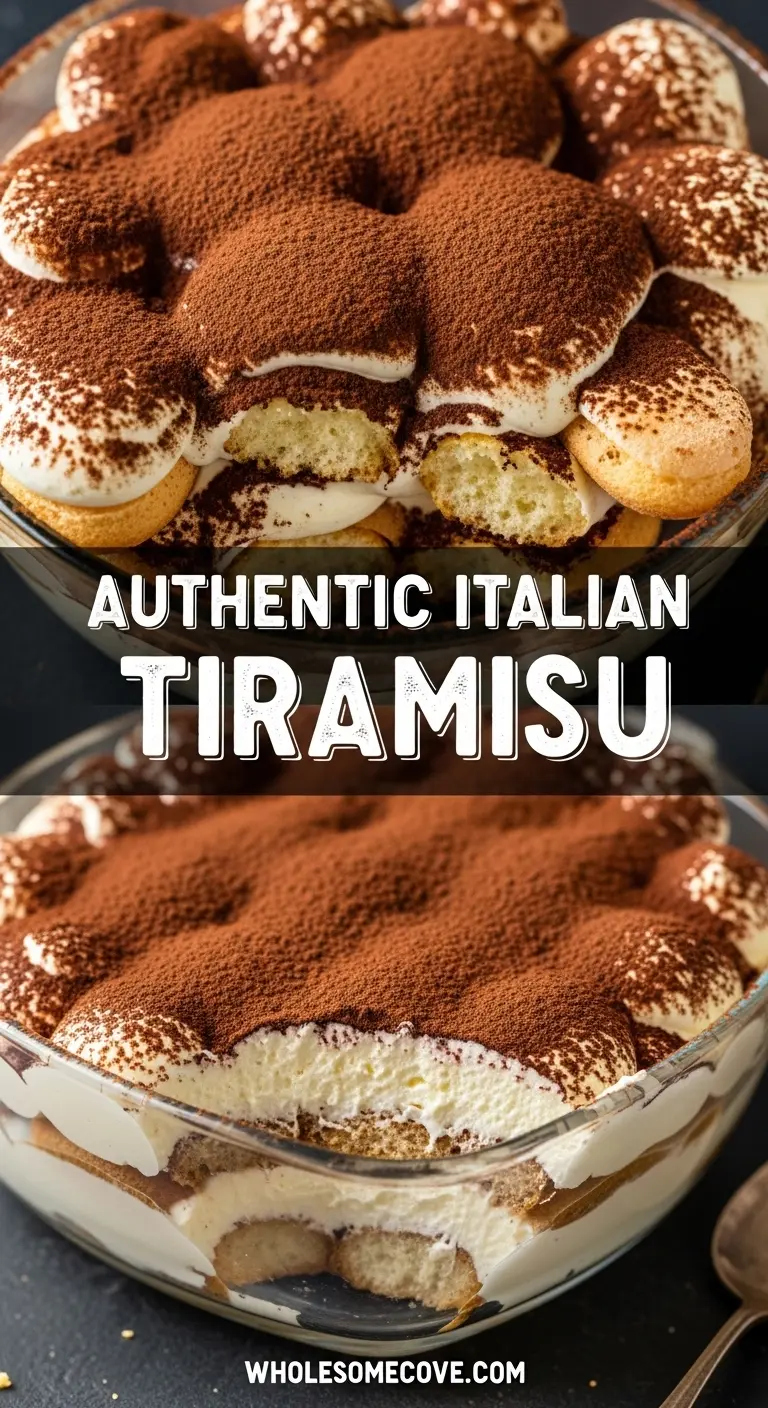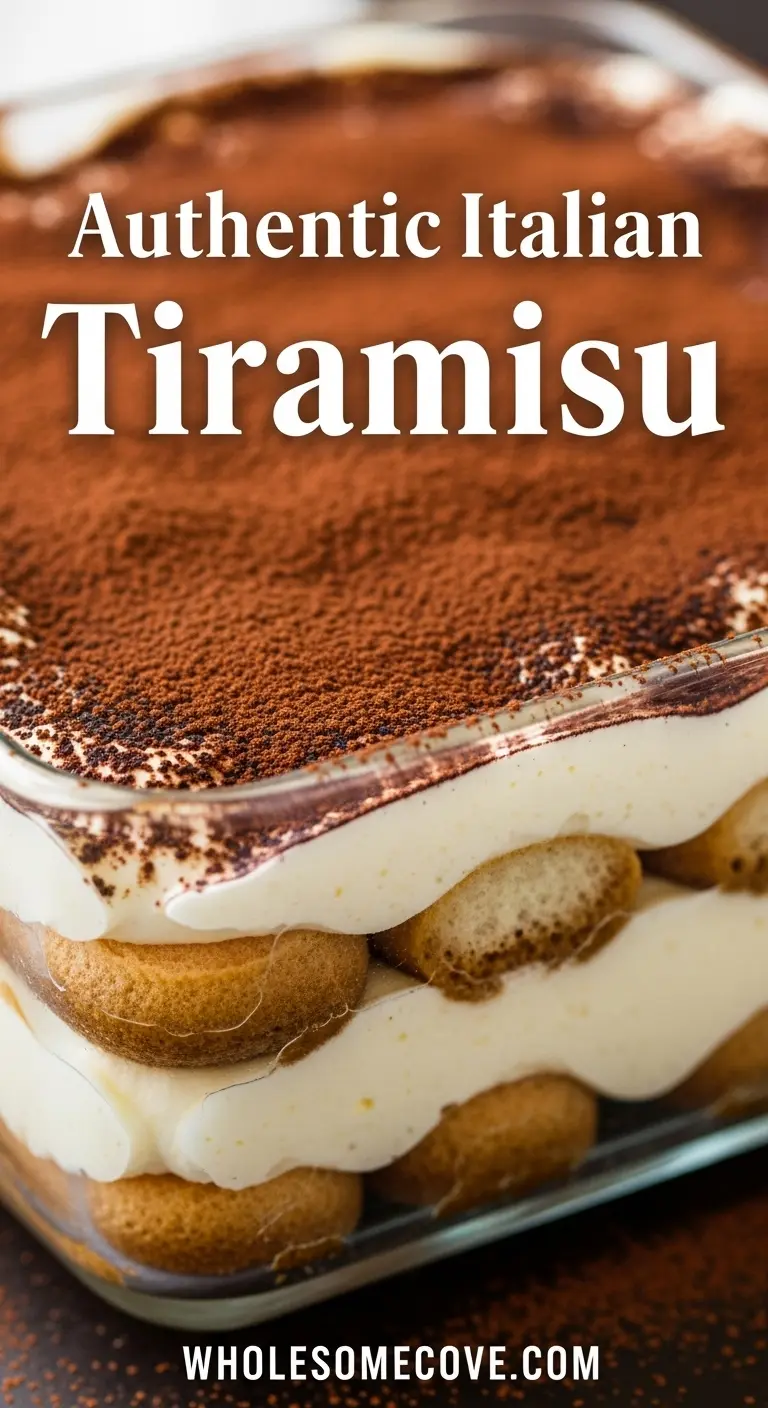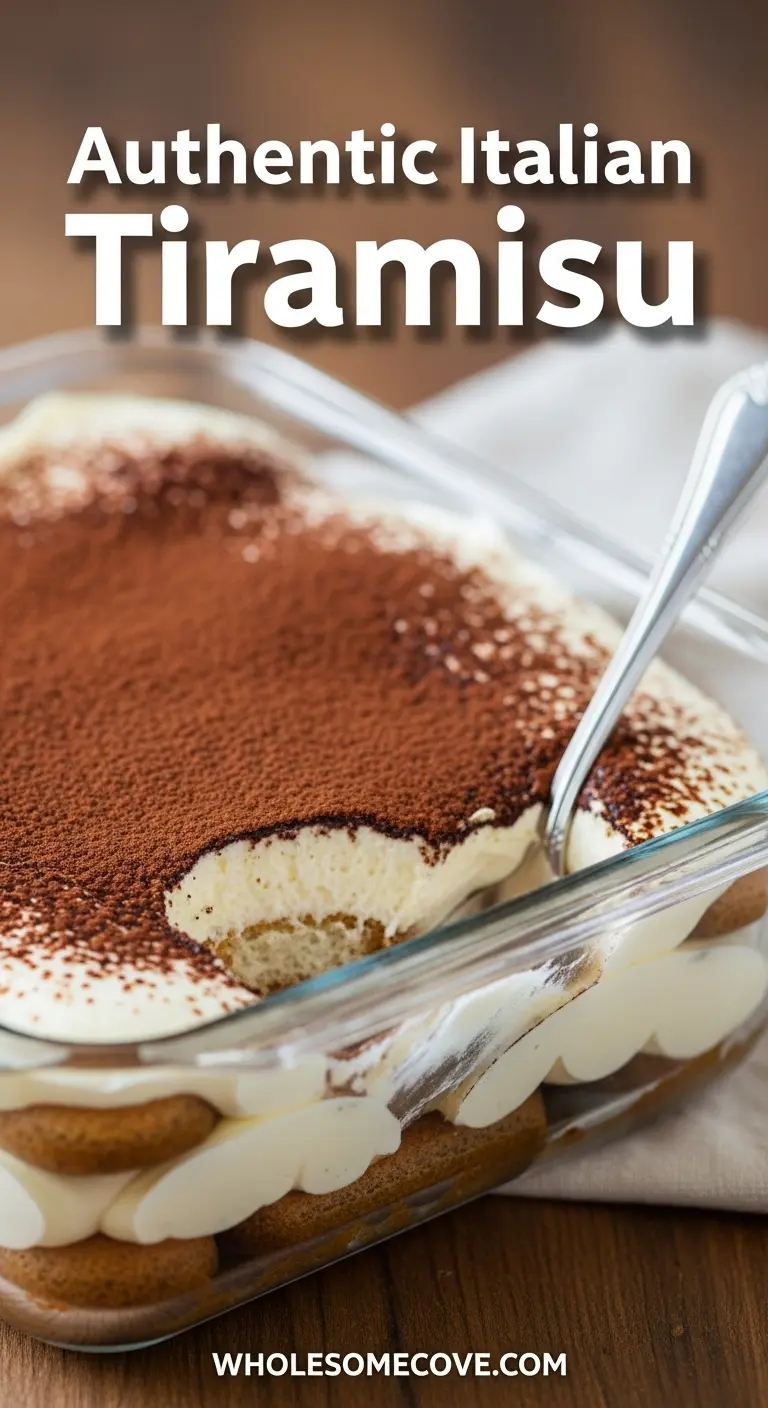My Italian grandmother would spend entire afternoons in her tiny kitchen, carefully crafting this iconic dessert while I watched from a wooden stool. I learned early on that making an authentic Italian tiramisu recipe isn’t just about following steps—it’s about understanding the delicate balance of flavors and textures that make this dessert legendary.
The first time I attempted this on my own, I made every rookie mistake possible. I used pre-ground coffee that tasted bitter, over-soaked my ladyfingers until they disintegrated, and whisked my egg whites into sad, deflated peaks.
But after years of practice and countless batches (my family didn’t complain), I’ve finally nailed the technique that produces silky mascarpone cream, perfectly coffee-soaked cookies, and that ethereal lightness that defines truly great tiramisu. This isn’t the heavy, overly sweet version you’ll find at chain restaurants.
This is the real deal—light, elegant, and sophisticated enough to end any dinner party on a high note.
| Quick Recipe Summary | |
|---|---|
| Prep Time | 30 minutes |
| Cook Time | 0 minutes |
| Chilling Time | 4 hours |
| Total Time | 4 hours 30 minutes |
| Servings | 12 servings |
| Difficulty Level | Intermediate |

Why You’ll Love This Authentic Italian Tiramisu Recipe
This tiramisu changed how my dinner guests view Italian desserts. The airy mascarpone cream melts on your tongue, while the espresso-soaked ladyfingers provide just enough structure without turning soggy.
Unlike American versions loaded with heavy cream and excessive sweetness, this authentic approach lets each component shine. The subtle kick of rum (or Marsala wine) adds complexity without overwhelming the coffee notes.
I’ve served this at everything from casual family dinners to formal celebrations, and it never fails to impress. Even people who claim they don’t like coffee desserts ask for seconds.
Here’s what makes this version special:
- Restaurant-quality results at home: You’ll achieve the same creamy, cloud-like texture found in top Italian restaurants
- Make-ahead friendly: The dessert actually improves after sitting overnight, making it perfect for entertaining
- No baking required: This is an ideal summer dessert when you don’t want to turn on the oven
- Authentic Italian technique: Using the traditional zabaglione method creates superior flavor and texture
- Customizable coffee strength: You control how intense the espresso flavor becomes
- Impressive presentation: The elegant layers look sophisticated with minimal effort
For another Italian-inspired dessert, you might enjoy my healthy tiramisu recipe.
Ingredients
Getting the right ingredients makes all the difference in achieving authentic tiramisu. I learned this the hard way when I tried substituting cream cheese for mascarpone—the result was grainy and sour rather than silky smooth. Each component plays a crucial role in creating those signature layers of coffee-soaked cookies and cloud-like cream.
For the Mascarpone Cream:
- 6 large egg yolks
- ¾ cup (150g) granulated sugar, divided
- 1⅓ cups (320ml) heavy whipping cream
- 1 pound (454g) mascarpone cheese, room temperature
- 2 tablespoons dark rum or Marsala wine (optional)
- 1 teaspoon pure vanilla extract
For the Coffee Mixture:
- 1¾ cups (420ml) strong brewed espresso or very strong coffee, cooled
- 3 tablespoons coffee liqueur (like Kahlúa), optional
- 2 tablespoons granulated sugar
For Assembly:
- 40-48 Italian ladyfinger cookies (savoiardi)
- 2-3 tablespoons unsweetened cocoa powder for dusting
- Dark chocolate shavings (optional garnish)
Kitchen Equipment Needed
Having the right tools makes preparing tiramisu significantly easier and helps achieve professional results. I used to struggle with improvised equipment until I invested in proper gear—now the process flows smoothly every time.
Here’s what you’ll need:
- Large mixing bowls (at least 3): Essential for keeping ingredients separated during preparation
- Electric hand mixer or stand mixer: Critical for whipping cream and egg yolks to proper consistency
- Medium saucepan: For creating the zabaglione base
- Whisk: Both for hand-whisking and reaching bowl edges
- Rubber spatula: For gently folding ingredients without deflating the mixture
- 9×13 inch glass baking dish or similar-sized serving dish: The classic size for layered tiramisu
- Shallow dish or pie plate: For dipping ladyfingers in coffee mixture
- Fine-mesh sieve or flour sifter: For dusting cocoa powder evenly
- Measuring cups and spoons: Precision matters in this recipe
- Instant-read thermometer: Helpful for monitoring egg temperature
- Plastic wrap or aluminum foil: For covering during chilling
Recommended Products for This Recipe
After making tiramisu dozens of times, I’ve discovered certain products that consistently deliver better results. These aren’t just random recommendations—they’re tools and ingredients that genuinely improve both the process and the final dessert.
1. Authentic Italian Savoiardi Ladyfingers
The right ladyfingers make or break tiramisu. Italian savoiardi are firmer and less sweet than American ladyfingers, which means they absorb coffee without turning to mush. I once used soft American-style cookies and ended up with tiramisu soup—not my finest moment. The Italian version maintains structure while still soaking up all those delicious espresso flavors.
2. BelGioioso Mascarpone Cheese
Not all mascarpone is created equal. After testing multiple brands, BelGioioso consistently delivers the creamiest, smoothest texture without any graininess. Some cheaper brands can taste slightly sour or have a chalky mouthfeel that ruins the delicate cream layers. This Italian-imported version blends effortlessly and creates that signature silky consistency.
3. Lavazza Espresso Powder
If you don’t have an espresso machine, this instant espresso powder is a lifesaver. It dissolves completely in hot water and delivers authentic Italian coffee flavor without any bitterness. I keep this in my pantry specifically for tiramisu—it’s more concentrated than regular instant coffee and provides the bold coffee taste this dessert demands.
4. Pyrex 9×13 Glass Baking Dish
A clear glass dish isn’t just pretty—it lets you see those beautiful layers from the side, which makes for stunning presentation. Pyrex is my go-to because it won’t react with acidic ingredients, goes straight from fridge to table, and cleans up easily. The straight sides also help create neat, professional-looking layers.
5. Valrhona Cocoa Powder
The final cocoa dusting is what people see first, so quality matters. Valrhona’s Dutch-processed cocoa is deeply chocolatey without any harsh, acidic notes. It sifts beautifully into an even layer and adds a sophisticated, slightly bitter contrast to the sweet cream. Regular grocery store cocoa works, but this elevates the entire dessert.
Another classic Italian dish worth exploring is chicken parmesan.

Step-by-Step Instructions: How to Make Authentic Italian Tiramisu
Making tiramisu requires patience and attention to detail, but I promise the results are worth every careful step. I’ve broken down the process into manageable sections so even first-time makers can achieve professional results.
1. Prepare the Zabaglione Base
The zabaglione (cooked egg yolk base) is what separates authentic Italian tiramisu from simplified versions. This step requires your full attention, but it creates incomparable richness and eliminates any concerns about raw eggs.
- Fill a medium saucepan with about 2 inches of water and bring it to a gentle simmer over medium heat
- In a large heatproof mixing bowl (preferably stainless steel), whisk together egg yolks and ½ cup (100g) sugar until the mixture becomes pale yellow and slightly thick
- Place the bowl over the simmering water (make sure the bottom doesn’t touch the water—this is a double boiler setup)
- Whisk constantly and vigorously for 8-10 minutes until the mixture reaches 160°F (71°C) on an instant-read thermometer and becomes thick, pale, and fluffy
- The mixture should form ribbons when you lift the whisk—if it drips off quickly, keep whisking
- Remove from heat and continue whisking for another 2-3 minutes to cool it down slightly
- Set aside to cool to room temperature (about 15 minutes)
2. Whip the Mascarpone Mixture
Getting the mascarpone to the right consistency is crucial for achieving that signature cloud-like texture. This step must be done gently to avoid overworking the cheese.
- In a separate large bowl, add the room-temperature mascarpone cheese (cold mascarpone won’t blend smoothly and may become lumpy)
- Using a hand mixer on low speed, beat the mascarpone for about 30 seconds just until smooth and creamy
- Add the vanilla extract and rum (if using) and mix on low speed for another 15-20 seconds until just combined
- Once the zabaglione has cooled to room temperature, gently fold it into the mascarpone using a rubber spatula
- Use broad, sweeping motions from the bottom of the bowl up and over, rotating the bowl as you fold
- Continue folding until the mixture is completely smooth and uniform in color with no streaks—this should take about 20-30 folds
- Be careful not to overmix, as this can make the mascarpone grainy
3. Whip the Heavy Cream
The whipped cream adds essential lightness to the mascarpone mixture. This step transforms heavy cream into those airy peaks that give tiramisu its ethereal quality.
- In a clean, cold mixing bowl (I often chill mine in the freezer for 10 minutes first), pour the cold heavy whipping cream
- Add the remaining ¼ cup (50g) sugar to the cream
- Using an electric mixer with clean beaters, start on low speed for about 30 seconds, then gradually increase to medium-high speed
- Beat for 3-4 minutes until soft peaks form—when you lift the beaters, the peaks should curl over softly at the tips
- Do not overbeat or you’ll end up with butter; stop as soon as you see soft peaks forming
- The cream should look glossy and smooth, not grainy or separated
4. Fold the Whipped Cream into Mascarpone
This folding technique is what creates the signature light, mousse-like texture of authentic tiramisu cream. Rushing this step will deflate all the air you’ve worked so hard to incorporate.
- Add about one-third of the whipped cream to the mascarpone mixture
- Using a rubber spatula, gently fold it in with broad, sweeping strokes—cut down through the center, sweep along the bottom, and bring the spatula up the side
- Rotate the bowl a quarter turn with each fold to ensure even mixing
- Once the first addition is mostly incorporated (a few streaks are fine), add half of the remaining whipped cream
- Fold gently until just combined, then add the final portion of whipped cream
- Continue folding until the mixture is uniform and fluffy with no white streaks visible
- The entire folding process should take about 2-3 minutes—if you rush and stir instead of fold, you’ll deflate the mixture
- The finished cream should be light, airy, and hold soft peaks when you lift the spatula
5. Prepare the Coffee Mixture
The coffee soaking liquid is where tiramisu gets its name and distinctive flavor. Getting the strength and sweetness right ensures your cookies absorb maximum flavor without becoming bitter.
- Brew strong espresso or very strong coffee (if using a regular coffee maker, use twice the amount of grounds you normally would)
- Pour the hot coffee into a shallow dish or wide bowl—a pie plate works perfectly
- Stir in 2 tablespoons of sugar until completely dissolved
- Add coffee liqueur if using and stir to combine
- Let the mixture cool to room temperature (about 10-15 minutes)—dipping ladyfingers in hot coffee will make them fall apart
- Taste the coffee mixture—it should be sweet enough to balance the bitter coffee but not syrupy
6. Dip and Layer the Ladyfingers (First Layer)
This is where many people go wrong—over-soaking turns ladyfingers to mush, while under-soaking leaves them dry and crunchy. Finding the sweet spot takes practice but makes all the difference.
- Working with one ladyfinger at a time, quickly dip it into the coffee mixture
- Submerge completely but only for 1-2 seconds per side—literally just a quick dunk
- The cookie should absorb coffee but still hold its shape firmly
- Immediately place the dipped ladyfinger in your 9×13 inch dish
- Continue dipping and arranging ladyfingers in a single layer to cover the bottom of the dish completely
- You should need about 20-24 ladyfingers for the first layer, depending on your dish size
- Arrange them tightly together with no gaps—break cookies in half if needed to fill spaces
- If some coffee mixture remains on the ladyfingers’ surface, that’s perfect—it will continue absorbing as it chills
7. Add the First Layer of Mascarpone Cream
Spreading the cream evenly ensures every bite has the perfect ratio of coffee-soaked cookies to creamy filling. This layer should be generous and smooth.
- Spoon about half of the mascarpone cream over the first layer of ladyfingers
- Use a rubber spatula or offset spatula to spread it evenly across the entire surface
- Make sure to spread the cream all the way to the edges and corners of the dish
- The cream layer should be about ½ inch thick and completely cover all the ladyfingers
- Smooth the top as evenly as possible—this makes the second layer of cookies easier to arrange
8. Add the Second Layer of Ladyfingers
The second layer follows the same dipping technique but requires a gentler touch since you’re placing cookies on soft cream rather than a firm dish bottom.
- Repeat the quick-dipping process with the remaining ladyfingers
- Gently place each dipped cookie on top of the cream layer
- Arrange them in the same tight pattern as the first layer
- Press down very lightly to help them nestle into the cream slightly, but don’t press hard enough to disturb the layer below
- You should use all remaining ladyfingers to create a complete second layer
- Any cookies that break during dipping can be pieced together—they’ll be covered with cream anyway
9. Add the Final Layer of Mascarpone Cream
This top layer is what people see first, so take extra care to make it smooth and attractive. The surface should look like creamy clouds.
- Spoon all remaining mascarpone cream over the second layer of ladyfingers
- Spread it evenly across the entire surface, making sure to cover every bit of cookie
- Use long, smooth strokes with your spatula to create an even, flat surface
- Work gently to avoid disturbing the layers below
- If you have any cream clinging to the sides of your mixing bowl, scrape it out and smooth it on top
- The finished top should be completely smooth with no ladyfingers visible
10. Chill the Tiramisu
Chilling time is non-negotiable for tiramisu—this is when all the flavors meld together and the texture transforms from separate components into a cohesive dessert.
- Cover the dish tightly with plastic wrap, pressing it directly onto the surface of the tiramisu to prevent a skin from forming
- Alternatively, you can use aluminum foil if you prefer
- Refrigerate for at least 4 hours, though overnight (8-12 hours) is ideal
- During chilling, the ladyfingers will continue softening, the cream will set slightly, and all the flavors will marry together
- The dessert can be made up to 24 hours ahead—in fact, I think it tastes even better the next day
11. Dust with Cocoa Powder Before Serving
The final cocoa dusting adds visual appeal and a subtle bitter note that balances the sweet cream perfectly. This should be done just before serving for the best appearance.
- Remove the tiramisu from the refrigerator and uncover it
- Place unsweetened cocoa powder in a fine-mesh sieve or flour sifter
- Hold the sieve about 6 inches above the tiramisu
- Gently tap or shake the sieve to create an even dusting of cocoa across the entire surface
- The cocoa layer should be visible but not so thick that it tastes bitter or powdery
- If desired, add chocolate shavings on top for extra elegance
- Use a sharp knife dipped in hot water (and wiped dry) to cut clean slices
- Wipe the knife clean between each cut for the neatest presentation
Read Also: Lasagna Recipe

Tips for The Best Authentic Italian Tiramisu
After years of making tiramisu, I’ve learned countless little tricks that separate good tiramisu from transcendent tiramisu. These tips will help you avoid common pitfalls and achieve professional results every time.
Temperature and Timing Tips:
- Bring mascarpone to room temperature: Cold mascarpone won’t blend smoothly and creates lumps that ruin the silky texture
- Cool your zabaglione completely: Adding warm egg mixture to cold cream creates an unpleasant grainy texture
- Use cold cream and bowl for whipping: Warm cream won’t whip properly into stiff peaks
- Let coffee cool before dipping: Hot coffee makes ladyfingers disintegrate instantly in your hands
- Chill overnight if possible: The extra time allows flavors to develop fully and creates the best texture
- Don’t skip the resting time: Tiramisu needs at least 4 hours to set properly—serving it too early results in runny cream
Ingredient Selection Tips:
- Use authentic Italian savoiardi: These firm, dry ladyfingers absorb coffee without becoming mushy
- Choose high-quality mascarpone: Cheap brands can be grainy or sour—look for imported Italian mascarpone
- Brew strong coffee or espresso: Weak coffee creates bland tiramisu without that signature coffee punch
- Use fresh eggs: Fresh eggs create more stable zabaglione and whip to better peaks
- Select Dutch-processed cocoa: It’s smoother and less acidic than natural cocoa for the final dusting
Technique Tips:
- Dip ladyfingers quickly: One to two seconds per side is plenty—they’ll continue absorbing liquid as they chill
- Fold, don’t stir: Stirring deflates the whipped cream, while folding preserves the airy texture
- Fill gaps with broken cookies: No one will notice pieced-together ladyfingers once they’re covered with cream
- Spread cream all the way to edges: Leaving gaps makes serving messy and looks unprofessional
- Create smooth, even layers: Take time to level each layer for the prettiest cross-section when serving
Make-Ahead and Serving Tips:
- Dust with cocoa just before serving: Cocoa powder absorbs moisture from the cream if added too early
- Use a hot, wet knife for clean cuts: Dip your knife in hot water, wipe it dry, then slice for neat portions
- Keep tiramisu chilled until serving: The cream can become too soft if left at room temperature too long
- Don’t freeze tiramisu: Freezing destroys the delicate texture—refrigeration only
- Serve within 48 hours: While safe to eat longer, tiramisu tastes best within two days of making
If you enjoy Italian recipes, try making marinara sauce from scratch.
Serving Suggestions

Tiramisu is elegant enough to stand alone, but the right accompaniments can elevate your dessert course into something truly memorable. I’ve found that keeping things simple works best—this dessert already delivers plenty of flavor and richness without needing much backup.
This classic Italian dessert pairs beautifully with these serving ideas:
- Fresh berries: Raspberries or strawberries add tartness that cuts through the rich cream
- Espresso or cappuccino: Serve alongside for the ultimate coffee lover’s experience
- Sparkling wine: A glass of Prosecco or Moscato d’Asti complements the dessert’s sweetness
- Biscotti: Offer these crispy Italian cookies for dipping in coffee between bites of tiramisu
- Whipped cream dollop: Add a small cloud of freshly whipped cream on each serving
- Chocolate shavings: Sprinkle extra dark chocolate curls on top for added elegance
- Amaretto liqueur: Drizzle a tiny amount over each portion for adults-only gatherings
- Mint leaves: A fresh mint sprig adds color and a subtle aromatic element
Variations of Authentic Italian Tiramisu
While traditional tiramisu is perfection, sometimes you want to experiment with flavors or adapt the recipe for dietary needs. These variations maintain the spirit of the original while adding interesting twists.
Here are my favorite ways to customize this classic dessert:
- Chocolate tiramisu: Add 3 tablespoons of unsweetened cocoa powder to the mascarpone cream and use chocolate syrup mixed with the coffee
- Limoncello tiramisu: Replace rum with limoncello and add lemon zest to the mascarpone cream for a bright, citrusy version
- Strawberry tiramisu: Layer thin-sliced fresh strawberries between the cream layers and reduce coffee to ½ cup
- Nutella tiramisu: Swirl ¼ cup warmed Nutella into the mascarpone cream for chocolate-hazelnut flavor
- Amaretto tiramisu: Replace rum with amaretto liqueur and add ½ cup crushed amaretti cookies between layers
- Pumpkin tiramisu: Fold ½ cup pumpkin puree and 1 teaspoon pumpkin spice into the mascarpone cream for fall
- Individual tiramisu cups: Layer the components in small glasses or mason jars for personal servings
- Tiramisu cake: Use the cream as filling between layers of vanilla sponge cake instead of ladyfingers
- Vegan tiramisu: Replace eggs with aquafaba, mascarpone with cashew cream, and heavy cream with coconut cream
- Gluten-free tiramisu: Use certified gluten-free ladyfingers or substitute with gluten-free pound cake
You might also love this healthy tiramisu recipe for a lighter version.
Storage and Reheating
Proper storage ensures your tiramisu maintains its texture and flavor for as long as possible. Since this is a delicate, cream-based dessert, following these guidelines carefully prevents spoilage and preserves quality.
Follow these storage guidelines to keep your tiramisu fresh:
- Refrigerator storage: Cover tightly with plastic wrap or aluminum foil and refrigerate for up to 3 days
- Best within 48 hours: Tiramisu tastes optimal during the first two days after making—after that, ladyfingers become very soft
- Keep covered: Exposure to air causes the cream to form a skin and absorb refrigerator odors
- Don’t stack items on top: The cream is delicate and will compress under weight
- Individual portions: Leftover single servings can be stored in airtight containers for up to 3 days
- Separate cocoa powder: If planning to store for more than a day, don’t add the cocoa dusting until serving—it becomes muddy when wet
- No freezing: Freezing destroys the texture of both the mascarpone cream and the ladyfingers—the dessert becomes watery and grainy when thawed
- No reheating needed: Tiramisu is served cold directly from the refrigerator—there’s no reheating involved
- Remove from fridge 5 minutes before serving: Taking slight chill off enhances flavors without compromising texture
- Cover cut edges: If serving from a partially eaten dish, press plastic wrap against cut surfaces to prevent drying
Nutritional Facts
Understanding the nutritional content helps you make informed decisions about portion sizes and how this dessert fits into your overall eating plan. Keep in mind that tiramisu is a special occasion treat rather than an everyday food.
Per serving (1/12 of recipe):
- Calories: 285
- Total Fat: 18g
- Saturated Fat: 10g
- Trans Fat: 0g
- Cholesterol: 165mg
- Sodium: 65mg
- Total Carbohydrates: 24g
- Dietary Fiber: 0.5g
- Sugars: 16g
- Protein: 6g
- Vitamin A: 15% DV
- Calcium: 8% DV
- Iron: 4% DV
Note: Nutritional values are approximate and calculated without alcohol. Adding rum or coffee liqueur increases calorie content by approximately 10-15 calories per serving.
For a lighter alternative, check out this healthy chocolate chip cookies recipe.
Health Benefits of Key Ingredients
While tiramisu is definitely an indulgent dessert, several of its components actually offer nutritional benefits. I’m not suggesting tiramisu is health food, but it’s nice to know you’re getting something positive along with all that deliciousness.
Here’s what the main ingredients contribute:
- Eggs: Rich in high-quality protein, vitamins A, D, E, and B12, plus essential minerals like selenium that support immune function and thyroid health
- Mascarpone cheese: Provides calcium for bone health, vitamin A for vision and immunity, and conjugated linoleic acid which may have anti-inflammatory properties
- Coffee: Contains powerful antioxidants that fight cellular damage, may improve mental alertness and focus, and has been linked to reduced risk of certain diseases
- Dark cocoa powder: Packed with flavonoids that support heart health, contains minerals like iron and magnesium, and provides antioxidants that combat oxidative stress
- Heavy cream: Supplies fat-soluble vitamins, provides energy, and contains compounds that may support brain function and hormone production
Another festive dessert to try is this Jamaican bread pudding.

FAQs About Authentic Italian Tiramisu
1. Can I make tiramisu without raw eggs?
Yes, and that’s exactly why this recipe uses the zabaglione method. By heating the egg yolks to 160°F (71°C) over a double boiler, we eliminate any food safety concerns while actually improving the texture and flavor. The cooked egg mixture creates a richer, more stable cream than using raw eggs.
2. What can I substitute for mascarpone cheese?
While mascarpone is traditional and creates the best texture, you can make a substitute by mixing 8 ounces softened cream cheese with ¼ cup heavy cream and 2 tablespoons sour cream. Beat until smooth. The result won’t be quite as silky or sweet, but it works in a pinch.
3. Can I make tiramisu alcohol-free?
Absolutely. Simply omit the rum or Marsala wine from the mascarpone cream—the dessert will still taste wonderful. You can also skip the coffee liqueur in the coffee mixture and add an extra tablespoon of sugar instead to maintain sweetness.
4. Why did my tiramisu turn out runny?
Runny tiramisu usually results from over-soaking the ladyfingers, not chilling long enough, or under-whipping the cream. Make sure you only dip ladyfingers for 1-2 seconds, whip cream to soft peaks, and refrigerate for at least 4 hours. Using too-soft mascarpone or adding warm zabaglione to cold ingredients can also create a runny texture.
5. How do I know when my whipped cream is at soft peaks?
Soft peaks form when you lift the beaters and the cream stands up but the tips curl over gently. If the peaks stand straight up, you’ve reached stiff peaks (too much for tiramisu). If the cream doesn’t hold any shape at all, keep beating for another 30-60 seconds.
Read Also: Healthy Pumpkin Pie Recipe
Final Thoughts
Making authentic Italian tiramisu might seem intimidating at first, but once you understand the technique, it becomes surprisingly straightforward. The key is patience—taking time to properly whip, fold, and chill each component.
I encourage you to try this recipe for your next dinner party or special celebration. Your guests will be genuinely impressed, and you’ll feel proud serving something so elegant and delicious.
Have you made tiramisu before? I’d love to hear about your experience or answer any questions in the comments below. And if you try this recipe, please come back and let me know how it turned out—your feedback helps me improve these recipes for everyone!
Recommended:
- Cannoli Poke Cake Recipe
- Healthy Apple Pie Recipe
- Amish Apple Cake Recipe
- Coffee Cake Recipe Using Cake Mix
- Healthy Carrot Cake Recipe
- Easy Carrot Cake Recipe
- Gaps Cream Cheese Dessert Recipe
- Funnel Cake Bites Recipe
- Are You Kidding Me Cake Recipe
- Mastros Butter Cake Recipe




